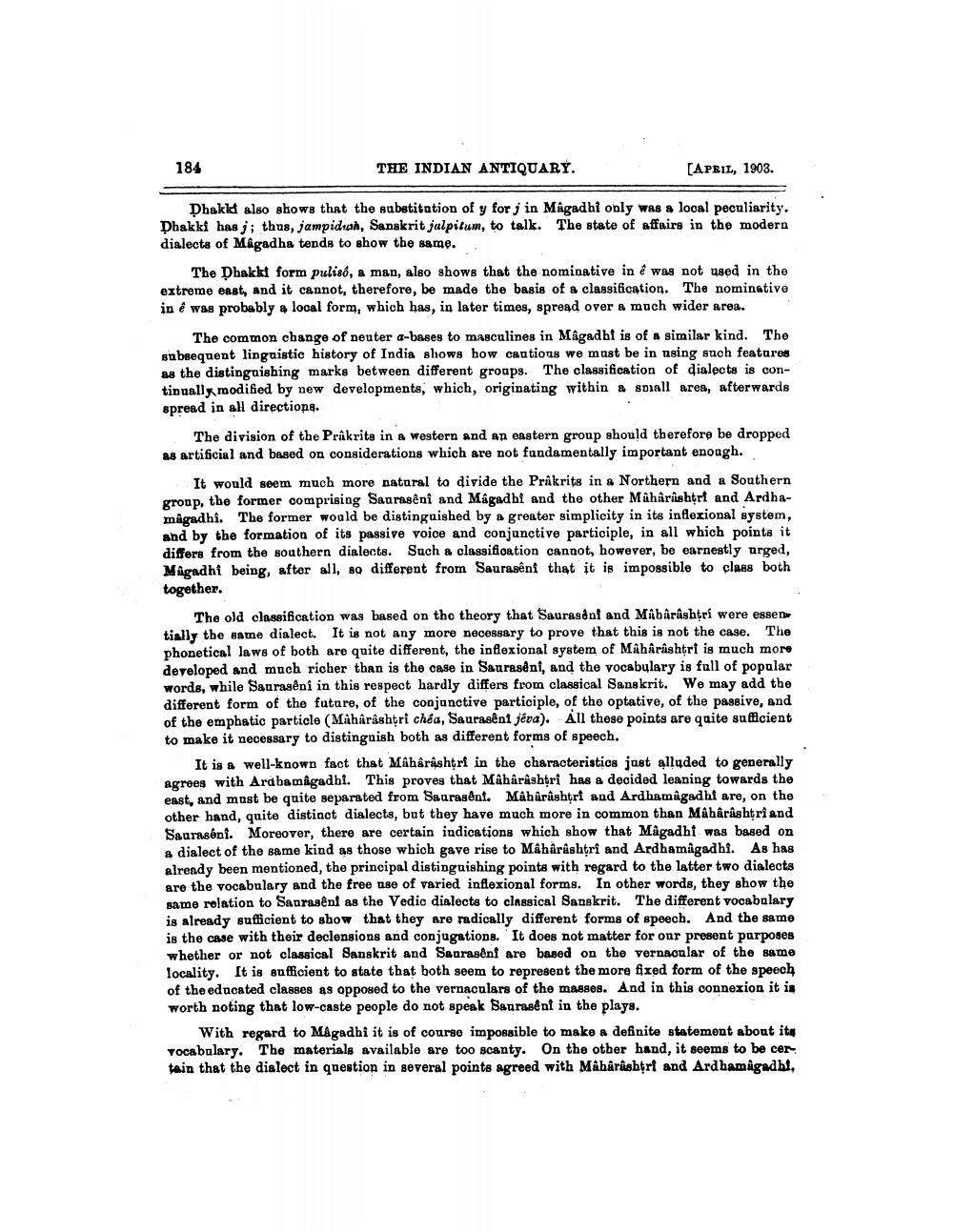________________
184
THE INDIAN ANTIQUARY.
[APRIL, 1903.
Dhakld also shows that the substitation of y forj in Magadhi only was a local peculiarity. Dhakki has ;; thus, jampidan, Sanskrit jalpitum, to talk. The state of affairs in the modern dialects of Magadha tends to show the same.
The Dhakkt form pulisó, a man, also shows that the nominative in ê was not used in the extreme east, and it cannot, therefore, be made the basis of a classification. The nominative in ê was probably & local form, which has, in later times, spread over a much wider area.
The common change of neuter a-bases to masculines in Mâgad bf is of a similar kind. The subsequent linguistic history of India shows how cautions we must be in using such features as the distinguishing marks between different groaps. The classification of dialects is continually modified by new developments, which, originating within a small area, afterwards spread in all directions.
The division of the Prakrits in a western and an eastern group should therefore be dropped as artificial and based on considerations which are not fandamentally important enough.
It would seem much more natural to divide the Prakrits in a Northern and a Southern group, the former comprising Saarasêni and Magadht and the other Maharashtrt and Ardhamagadhi. The former would be distinguished by a greater simplicity in its inflexional system, and by the formation of its passive voice and conjunctive participle, in all which points it differs from the southern dialects. Such a classification cannot, however, be earnestly urged, Migadhi being, after all, so different from Saurasêni that it is impossible to class both together.
The old classification was based on the theory that Saurasdnl and Maharashtrí were essen tially the same dialect. It is not any more necessary to prove that this is not the case. The phonetical laws of both are quite different, the inflexional system of Maharashtri is much more developed and much richer than is the case in Saurasêni, and the vocabulary is full of popular words, while Saurasêni in this respect hardly differs from classical Sanskrit. We may add the different form of the future, of the conjunctive participle, of the optative, of the passive, and of the emphatic particle (Maharashtri chéa, Saurasêni jéva). All these points are quite sufficient to make it necessary to distinguish both as different forms of speech,
It is a well-known fact that Maharashtri in the characteristics just alluded to generally agrees with Arabamagadhi. This proves that Maharashtri has a decided leaning towards the east, and must be quite separated from Saurasenf. Mâhârâshtri and Ardhamagadh are, on the other hand, quite distinct dialects, but they have much more in common than Mâhârâshtri and Saurasóni. Moreover, there are certain indications which show that Magadh was based on a dialect of the same kind as those which gave rise to Mâhârâshtri and Ardhamagadhi. As has alrendy been mentioned, the principal distinguishing points with regard to the latter two dialects are the vocabulary and the free use of varied inflexional forms. In other words, they show the same relation to Saurasen as the Vedic dialects to classical Sanskrit. The different vocabulary is already sufficient to show that they are radically different forms of speech. And the same is the case with their declensions and conjugations. It does not matter for our present parposes whether or not classical Sanskrit and Saurasênf are based on the vernacular of the same locality. It is sufficient to state that both seem to represent the more fixed form of the speech of the educated classes as opposed to the vernaculars of the masses. And in this connexion it is worth noting that low-caste people do not speak Saurasent in the plays.
With regard to Magadhi it is of course impossible to make a definite statement about its vocabulary. The materials available are too scanty. On the other hand, it seems to be certain that the dialect in question in several points agreed with Maharashtrt and Ardhamagadhl.




